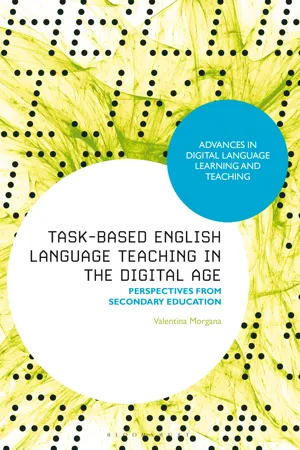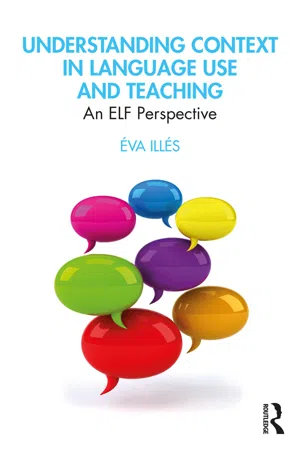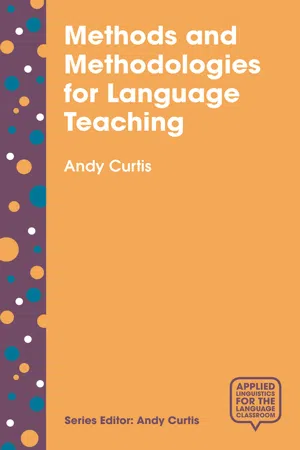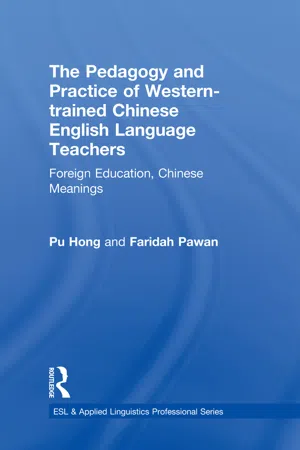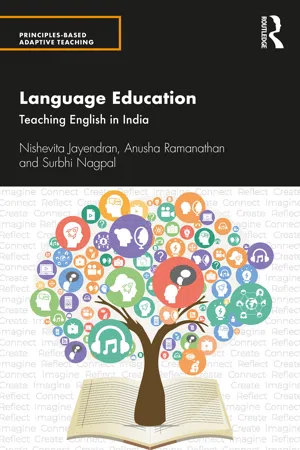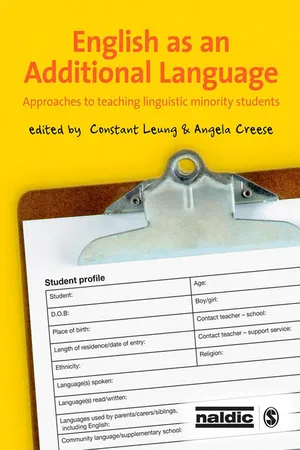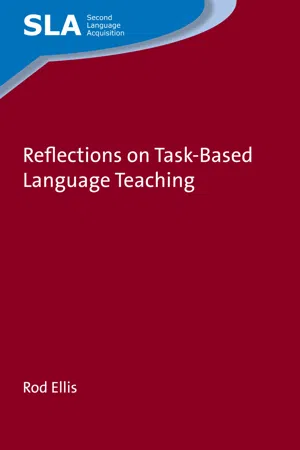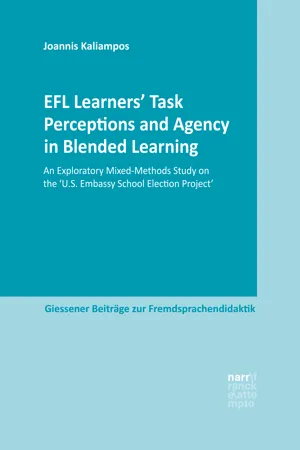Languages & Linguistics
Communicative Language Teaching
Communicative Language Teaching (CLT) is an approach to language education that emphasizes real-life communication and interaction. It focuses on developing students' ability to use the target language in authentic situations, rather than just on memorizing grammar rules and vocabulary. CLT encourages students to engage in meaningful conversations, role-plays, and other interactive activities to improve their language skills.
Written by Perlego with AI-assistance
Related key terms
Related key terms
1 of 4
Related key terms
1 of 3
10 Key excerpts on "Communicative Language Teaching"
- eBook - ePub
Task-Based English Language Teaching in the Digital Age
Perspectives from Secondary Education
- Valentina Morgana(Author)
- 2023(Publication Date)
- Bloomsbury Academic(Publisher)
Language learning and teaching has experienced a series of significant changes over the last forty years, mostly due to the need to find effective methods (Power & Shrestha, 2009) of fostering second and foreign language learning. What is striking is that there has been a clear move away from a traditional teacher-centred method, such as grammar-translation, to more student-centred methods such as Communicative Language Teaching (CLT) and Task-Based Language Teaching (TBLT). This volume has been designed to investigate the use of technology-mediated TBLT approaches in the EFL classroom. In the first part of this chapter, I will provide an overview of the two approaches and review the relevant studies on CLT and TBLT’s integration with technology.2. Historical background 2.1 Communicative Language TeachingA communicative approach to language teaching uses realistic life situations based on the lives of students to foster language learning and develop their functional competence (Canale & Swain, 1981). A communicative (or functional/notional) approach is organized according to functions (e.g. describing, inviting, apologizing) that learners need to know in order to address real-life situations. Communicative activities are interactive and clearly relate to students’ experiences, thus motivating learners to communicate in meaningful ways about subjects of interest (Richards & Rodgers, 2001). The main objective of Communicative Language Teaching is to develop learners’ communicative competence in a target language (Littlewood, 2007). It represents the response to the need for ‘genuine communication in L2 classrooms’ (East, 2021: 34). As stated by East (East, 2008: 14) ‘language exists for purposes of real communication with real individuals in real contexts’.In his analysis of CLT over forty years, Littlewood (Littlewood, 2014) identifies two different versions of CLT: a communicative perspective on language and a communicative perspective on learning (Littlewood, 2014: 351). A communicative perspective on language is about what we learn, not specifically in terms of language structures, but in terms of communicative functions. Examples of classroom activities related to this approach are activities in which learners are asked to ‘do things with the language’ (Wilkins, 1976) such as role-plays, pair work discussion, use of authentic materials etc. On the other hand, a communicative perspective on learning focuses on how we learn a language in terms of natural acquisition, with no or limited help from a teacher (Terrell & Krashen, 1983). For these reasons, the communicative perspective on learning is identified as the strong version of CLT, while the communicative perspective on language is the weaker version. Although innovative in many ways, both versions (weak and strong) were viewed as incomplete (East, 2012) or too extreme (Long, 2015). This led to the emergence of the TBLT approach. - eBook - ePub
Understanding Context in Language Use and Teaching
An ELF Perspective
- Éva Illés(Author)
- 2020(Publication Date)
- Routledge(Publisher)
5Context in Language Teaching
Introduction
The language teaching approach that is concerned with the pragmatics of language use is Communicative Language Teaching (CLT). CLT aims to teach learners of a second language to communicate and enable them “to do things with their words” (Cook, 2010, p. 16). CLT is thus directly related to pragmatics: It focuses on the “pragmatics of communication” (Cook, 2010, p. 26) and has the pragmatic function as its defining feature (Widdowson, 2009). The main concern is language use (Harmer, 2007), that is, “language as it is used in a real context” (Larsen-Freeman, 2000, p. 125), which makes contextualisation in CLT “a basic premise” (Richards & Rodgers, 2001, p. 156).The developments in linguistic theory and dissatisfaction with the structural-oral-situational approach and the audiolingual method have led to the introduction of CLT in language teaching (Richards & Rodgers, 2001; Widdowson, 2009). The shift of interest from structure and form to language use in linguistics has been transferred into language teaching and changed the basic tenets of how languages should be taught. It has been claimed that the main different between pre-CLT approaches and methods and CLT is that, whereas the former focuses on the linguistic system of the target language (TL), CLT’s main concerned is meaning (Richards & Rodgers, 2001; Rodgers, 2009). However, Widdowson argues (1998) that, in effect, what distinguishes CLT from previous language teaching movements is not that the pre-CLT approaches emphasise form rather than meaning, but the fact that while pre-CLT approaches promote the teaching of semantic meaning, in CLT the aim is to engage learners in the construction of pragmatic meaning, which then necessarily implies context. The example of “I am walking to the door” (Widdowson, 1998, p. 707) in the previous chapter illustrates the difference between attending to semantic or pragmatic meaning. In pre-CLT approaches the utterance is used to demonstrate the meaning of the present progressive tense with the teacher walking to the classroom door, thus replicating what can already be seen. In real-life communication, however, the purpose is not to display encodings but to get some intention across. If, for example, the host at a dinner party was walking to the door and describing their action at the same time, the guest would think that the speaker wants to convey an implicature, such as, “[H]e means he is going to call the police” (p. 707). In the actuality of language use, context is not duplicated but implied unless the speaker wants to convey an implicature as in the sample above. When there is reference to meaning in CLT, it happens in this pragmatic sense where context is invoked and complements language in communication. In Seidlhofer and Widdowson’s (2019) summary: - eBook - ePub
Methods and Methodologies for Language Teaching
The Centrality of Context
- Andy Curtis(Author)
- 2017(Publication Date)
- Bloomsbury Academic(Publisher)
4Communicative Language Teaching in ContextBefore reading this chapter, consider the following questions:- How would you define ‘communication’?
- What do you understand by the term ‘communicative competence’?
- Do you think ‘effective communication’ and/or ‘communicative competence’ is the same in your first language as it is in your other languages?
- If so, why? Or, if not, why not?
Introduction and OverviewIn this chapter, definitions (including my own) and descriptions of Communicative Language Teaching (CLT) are first presented, compared and contrasted, so that the readers can fully understand what is meant by CLT. This is a necessary starting point, because CLT can mean different things to different people, depending in no small part on how we conceptualize and articulate essential terms such as ‘communication’, ‘effective communication’ and ‘communicative competence’. In the second part of the chapter, the readers are taken inside the CLT classroom to give them a sense of what CLT looks like, linking the theory and the practice of CLT, using data from real classrooms, such as extracts from classroom transcripts.The third part of the chapter considers the pros and cons of CLT, as all methodologies have their benefits and limitations, to help the readers decide whether CLT is or would be a good fit with their particular language teaching and learning context. In this chapter, I also discuss what I refer to as ‘the dark side of CLT’, as one of the features of this book that distinguishes it from other books on methodology is the fact that the methodologies presented here are critically considered. By that, I mean they are considered in relation to the historical, geopolitical, cultural, economic, post-colonial and other aspects that have shaped the methodology. These considerations are designed to be different from the presentation of each methodology in some ‘neutral’ way, as though such aspects were not essential influences, when they clearly are key. The last part of the chapter includes a brief discussion of how the learning outcomes with CLT can be assessed. - eBook - ePub
The Pedagogy and Practice of Western-trained Chinese English Language Teachers
Foreign Education, Chinese Meanings
- Pu Hong, Faridah Pawan(Authors)
- 2015(Publication Date)
- Routledge(Publisher)
60). Originally conceived by Dell Hymes in 1972, the notion of communicative competence was further developed by Canale and Swain (1980) to go beyond linguistic competence to include sociolinguistic, discourse, strategic, and grammatical competencies. Sociolinguistic competence consists of learners’ ability to use the language appropriately in social situations; discourse competence refers to their ability to combine grammar and meaning to express themselves in new, different, and fluent ways; strategic competence is the use of verbal and nonverbal strategies to cope with challenges of communication; and grammatical competence is the accurate and effective use of the features and rules of language. Jacobs and Farrell (2003) went on to identify eight defining elements underlying CLT principles, namely: (a) learner autonomy; (b) the social nature of learning; (c) curricular integration of English into other subjects; (d) focus on meaning through content-based language instruction; (e) diversity and students’ individual differences in learning; (f) language as a means to promote critical and creative thinking; (g) multiple and authentic assessments; and (h) teachers as colearners in the classroom. Overall, the purpose remains the development of adequate activities and opportunities for students to use their English for real communication and authentic purposes. CLT Classroom Highlights Three defining features of CLT classroom instruction have emerged from the elements discussed above, namely, (a) student-centeredness, (b) flexible teacher roles, and (c) purposeful and scaffolded activities that promote communicative engagement. Student-Centeredness In a student-centered classroom, students’ readiness for autonomy is acknowledged. In addition, they are seen not simply as learners but as managers of their learning - eBook - ePub
Language Education
Teaching English in India
- Nishevita Jayendran, Anusha Ramanathan, Surbhi Nagpal(Authors)
- 2021(Publication Date)
- Routledge India(Publisher)
They focus on language fluency through real-life, authentic activities. Contrary to popular misconceptions that CLT-focussed activities stress speaking and listening skills alone, the CLT classroom addresses all language components through meaningful integrated activities. CLT is thus an approach that informs the planning and design of tasks ranging from role plays ; information gap activities ; speaking and conversation activities ; information gathering tasks, such as interviews; and sharing points of view and experiences, such as writing a recipe, creating invitations for school events, designing classroom games and so on) (Richards, 2006). Littlewood (2007), in his paper outlines a framework that designates activities on a communicative continuum. Non-communicative learning comprises tasks that are drills-and-rule-based or memory-based. Pre-communicative tasks primarily focus on language structure but offer some scope for meaningful language use, such as finding answers to comprehension questions from the text. Communicative practice shifts focus and emphasises communication through finding and sharing information such as information/reasoning gap activities found, for instance, in map-reading exercises. Structured communication allows for interaction and communication through role plays and interviews. Authentic communicative tasks involve real-life interactions through project work, debates, etc. (Littlewood, 2007). Littlewood emphasises that teachers who use the CLT approach in their classroom can aim to move towards the other continuum by passing slowly through all categories rather than through a dramatic shift from the first to fifth categories. Such an approach aligns with the Postmethod framework, as it allows teachers to consider learners’ backgrounds, levels, educational contexts and cultures, thereby successfully adapting it to their classrooms. Analyse the activities discussed in this chapter - eBook - ePub
English as an Additional Language
Approaches to Teaching Linguistic Minority Students
- Constant Leung, Angela Creese, Constant Leung, Angela Creese(Authors)
- 2010(Publication Date)
- SAGE Publications Ltd(Publisher)
Given that language teachers and learners are not researchers and that they cannot know every possible communicative situation which their students may encounter, an interesting question here is what constitutes Communicative Language Teaching in the classroom. For example, Brown (2001: 43) offers a set of characteristics that includes the following: 6 attending to ‘the components (grammatical, discourse, functional, sociolinguistic, and strategic) of communicative competence’; using activities and tasks that would ‘engage learners in the pragmatic, authentic, functional use of language for meaningful purposes’; ‘[s]tudents are therefore encouraged to construct meaning through genuine linguistic interaction with others’. These characteristics suggest that, instead of finding out what people actually do when they use language to communicate with one another in specific contexts, Communicative Language Teaching has turned its focus to creating language-using activities in the classroom to facilitate practice in communication (for a fuller discussion, see Leung, 2005). The term Communicative Language Teaching is not often explicitly invoked in EAL programmes and teacher education materials. 7 This is, however, not to say that the general principles underpinning Communicative Language Teaching have not made any impact - eBook - ePub
Innovation in Language Teaching and Learning
The Case of Japan
- Hayo Reinders, Stephen Ryan, Sachiko Nakamura, Hayo Reinders, Stephen Ryan, Sachiko Nakamura(Authors)
- 2019(Publication Date)
- Palgrave Macmillan(Publisher)
activities , meaning-focused tasks, and so on.Thirty years on from the publication of Clark’s work, goals in education seem to be geared towards developing general purpose competences (e.g., communication, collaboration and critical thinking skills as seen in ‘21st century skills’ in the USA and ‘key competences’ in the EU, which students in this fast-growing, globalized information-based society are required to acquire). Following Clark’s logic, I would call this ideological trend globalism and argue that Content and Language Integrated Learning (CLIL) is the language education approach required for achieving these aims. Keeping such connections between educational goals and ELT methodologies in mind, this chapter outlines the basic principles and techniques of CLIL as an innovative approach to language learning and teaching, discusses the key factors that are attracting a growing number of ELT professionals in Japan to this approach, and then takes up a case study of a maths CLIL program at a primary school so as to share the experiences and insights gained through a specific longitudinal project.Area of Innovation
One of the most frequently cited definitions of CLIL is it “is a dual-focused educational approach in which additional language is used for the learning and teaching of both content and language” (Coyle, Hood, & Marsh, 2010 , p. 1). Although this simple definition succeeds in expressing the core feature of CLIL (i.e., integration of content and language learning), more explanation should be added to reveal its substantial principles and potentials. This is actually provided by one of the authors of the above-cited book through the well-known framework referred to as “the 4 Cs” of CLIL (Coyle, 2007 ; Coyle et al., 2010 ): Content (subject matter, topics, themes), Communication (language knowledge, skills, interaction), Cognition (lower-order and higher-order thinking skills ), and Culture (collaborative learning and global citizenship). This framework is crucial for CLIL practitioners as teachers’ intentional incorporation of the 4 Cs in their lessons is what differentiates CLIL from other content-based approaches such as Content-Based Instruction (CBI), English-Medium Instruction (EMI), and immersion - eBook - ePub
- Rod Ellis(Author)
- 2018(Publication Date)
- Multilingual Matters(Publisher)
CLT was an ‘approach’ rather than a well-defined ‘method’. Howatt (1984) distinguished a weak and strong version. In the weak version teaching content was defined in terms of the linguistic realizations of notions and functions but the methodology remained essentially the same as in the traditional structural approach – a Type A approach. In the strong version, the content of a language programme was specified in terms of communicative tasks and the methodological focus was on fluency – a Type B approach. There were also proposals for combining the two approaches as in Johnson’s ‘communicative procedure’ and Brumfit’s modular curriculum. As we will see, this attempt to encourage fluency while not neglecting accuracy figures too in TBLT.CLT has had a major impact throughout the world. Nunan (2003), for example, reported that the educational policies of seven countries in the Asian region mandated the use of CLT. Its influence in Europe has been even greater with the European Common Language framework providing the basis for the teaching and assessment of languages throughout the region. Just about every course book emanating from major publishers today lays claim to being ‘communicative’. As its influence has spread, however, CLT has become increasingly less well defined. Littlewood (2014) noted its vagueness, commenting ‘the most common understanding has been that it means teachers including communicative activities in their repertoire’ (2014: 350). Today even approaches based on a structural syllabus and a presentation–practice–production (PPP) methodology lay claim to being ‘communicative’ on the grounds they include a communicative task in the final production stage. Clearly, such an interpretation represents an even weaker version of CLT than Howatt’s ‘weak version’, creating the space for TBLT to take over the reins of the ‘strong version’.Second language acquisition researchSLA research also contributed to the emergence of TBLT. The 1960s and 1970s saw a number of cross-sectional and longitudinal studies of learners acquiring an L2 naturalistically (e.g. Cancino et al. , 1978; Dulay & Burt, 1973). The cross-sectional studies examined the accuracy with which a set of English grammatical morphemes (e.g. Ving, plural-s, Ved, 3rd person-s) were produced by different groups of learners. They resulted in the claim that there was an acquisition order that was common to all learners irrespective of their first Languages (L1) or their age. Furthermore, a very similar order was found in classroom learners suggesting that instruction did not have a major impact on the developmental route learners followed. The longitudinal studies focused on individual learners’ acquisition of specific grammatical structures (e.g. negatives, interrogatives and relative clauses). They showed that learners did not progress directly from zero knowledge of these structures to target-like use but instead passed through a series of stages involving ‘transitional constructions’ en route - eBook - ePub
EFL Learners' Task Perceptions and Agency in Blended Learning
An Exploratory Mixed-Methods Study on the 'U.S. Embassy School Election Project'
- Joannis Kaliampos(Author)
- 2022(Publication Date)
- Narr Francke Attempto Verlag(Publisher)
Informed by these educational principles, CLT emerged from parallel developments in Europe and North America as an innovative, yet loosely delineated approach to language education, based on functional-notional concepts of language use (Savignon, 2000). In Europe, for instance, increases in work-related migration and so-called ‘guest worker’ programs in the 1970s prompted the Council of Europe to develop a language syllabus consisting of functional-notional concepts of language use, based on an assessment of learners’ needs, and the definition of threshold levels of language ability in terms of can-do statements describing learners’ expected competencies (ibid., p. 125). Such an approach was highly relevant to the new field of language for specific purposes, which focused on the particular needs of adult language learners for their respective professional fields and daily activities (e.g., communicating with co-workers, being interviewed for a job, presenting themselves at agencies, or shopping for groceries). While this approach focused on the product of language education (i.e., communicative competence in specific work and leisure fields), a different argument was made in West Germany, influenced by the social-democratic reform movement for learner empowerment and the work of philosopher Jürgen Habermas, to reform the process of classroom-based (language) learning (cf. Legutke, 2008). In a radical departure from the predominance of synthetic syllabi, Piepho (1974), an influential contributor to this debate, stipulated in CLT, successful language acquisition requires a flexible and differentiated learning environment, which facilitates communication, sparks communicative intentions, provides linguistic resources and practice opportunities, as well as adamantly refuses to prescribe uniform learning paths (Piepho, 1974, p. 141). In essence, this impetus was a reaction to then predominant foreign language classroom practices that viewed language as a grammatical and linguistic rule system, not a communicative tool for sociocultural mediation. These classrooms criticized by Piepho were notorious for their lack of creativity, communication opportunities, learner autonomy, and cultural awareness (Legutke & Thomas, 1991). By contrast, communicative competence for Piepho (1974) essentially included linguistic competence (i.e., the ability to produce and understand language by using linguistic means and strategies appropriate to topic, interlocutors, and situation) as well as discourse competence (i.e., the meta-cognitive and reflective ability to evaluate the appropriateness of linguistic means and justify their use). Likewise, Hymes (1971) focused on language as social behavior and put forth an understanding of communicative competence, which necessarily combined knowledge of linguistic forms with an awareness of sociolinguistic appropriacy in concrete situations of use.In the German context, the emergence of CLT and task-based approaches were closely interconnected as educators and teacher trainers grew increasingly dissatisfied with the lack of published instructional materials addressing the sociolinguistic, pragmatic, and intercultural notions of communicative competence and took it upon themselves to develop task and exercise compendiums (Candlin, 1978; cf. Hallet & Legutke, 2013). These publications advanced four critical arguments regarding the communicative foreign language classroom (Hallet & Legutke, 2013, pp. 140–1): - eBook - ePub
What English Language Teachers Need to Know Volume III
Designing Curriculum
- MaryAnn Christison, Denise E. Murray(Authors)
- 2021(Publication Date)
- Routledge(Publisher)
Chapter 1 ) was using a communicative approach and was learner centered, but teachers and learners were not making full use of CLT methodologies so that learners could use English in communicative situations (that is, the implemented curriculum differed from the intended curriculum). Therefore, he proposed a competency-based approach because CBLT “seeks to bridge the wall between school or the classroom and everyday real life” (p. 519). To help teachers implement such an approach, he lays out the content and language components for different competencies in the curriculum, such as “describing a job.” Riyandari (2004), in contrast, details the difficulties of implementing such a CBLT approach in Indonesian universities, where the goal of the introduction of CBLT across sectors in Indonesia was to prepare students to communicate in English in the job market. However, CBLT encourages autonomy of learners, which is culturally inappropriate for many Indonesians. In addition, teachers are not knowledgeable about the basic characteristics and procedures of the approach, classes are too large to have dynamic interactions, and teachers have poor mastery of English (Marcellino, 2008). These challenges mitigate against learners achieving the communicative objectives in the curriculum. We now provide detailed examples of implementation of CBLT in the United States, Australia, and Canada.Adult ESL Education in the United States
As indicated in the vignette, CASAS is a competency-based assessment model. It grew out of California’s concern in the 1970s with the variety of instructional models used in adult education that had no overarching rationale. CASAS was developed by the California Department of Education and a consortium of local adult education agencies in order to provide a consistent approach to adult ESL. Since then, it has been adopted by most U.S. states, largely because, initially, refugees had to be enrolled in a CBLT program for the institution to receive federal funding and CASAS was the only adult assessment system of its kind to be approved and validated by the U.S. Department of Education in the area of adult literacy. CASAS has adapted to the different federal reporting requirements, such that currently the CASAS assessment and reporting system meets the accountability requirements of the U.S. Department of Labor’s Workforce Investment Opportunities Act of 2017. As well as being used in all U.S. states, it is used in Singapore and other countries outside the United States. CASAS focuses on employment and life skills for adults and youth, using specific, measurable competency statements. The competencies cover a range of different topic areas:
Index pages curate the most relevant extracts from our library of academic textbooks. They’ve been created using an in-house natural language model (NLM), each adding context and meaning to key research topics.
Explore more topic indexes
Explore more topic indexes
1 of 6
Explore more topic indexes
1 of 4
